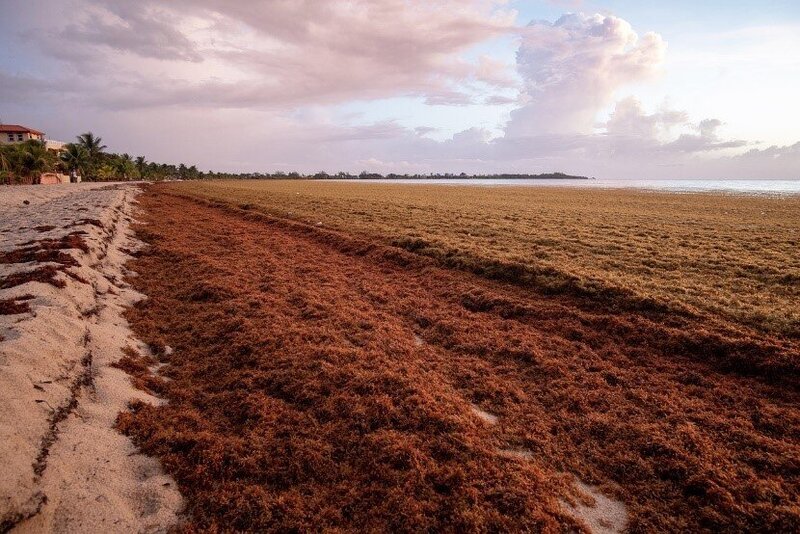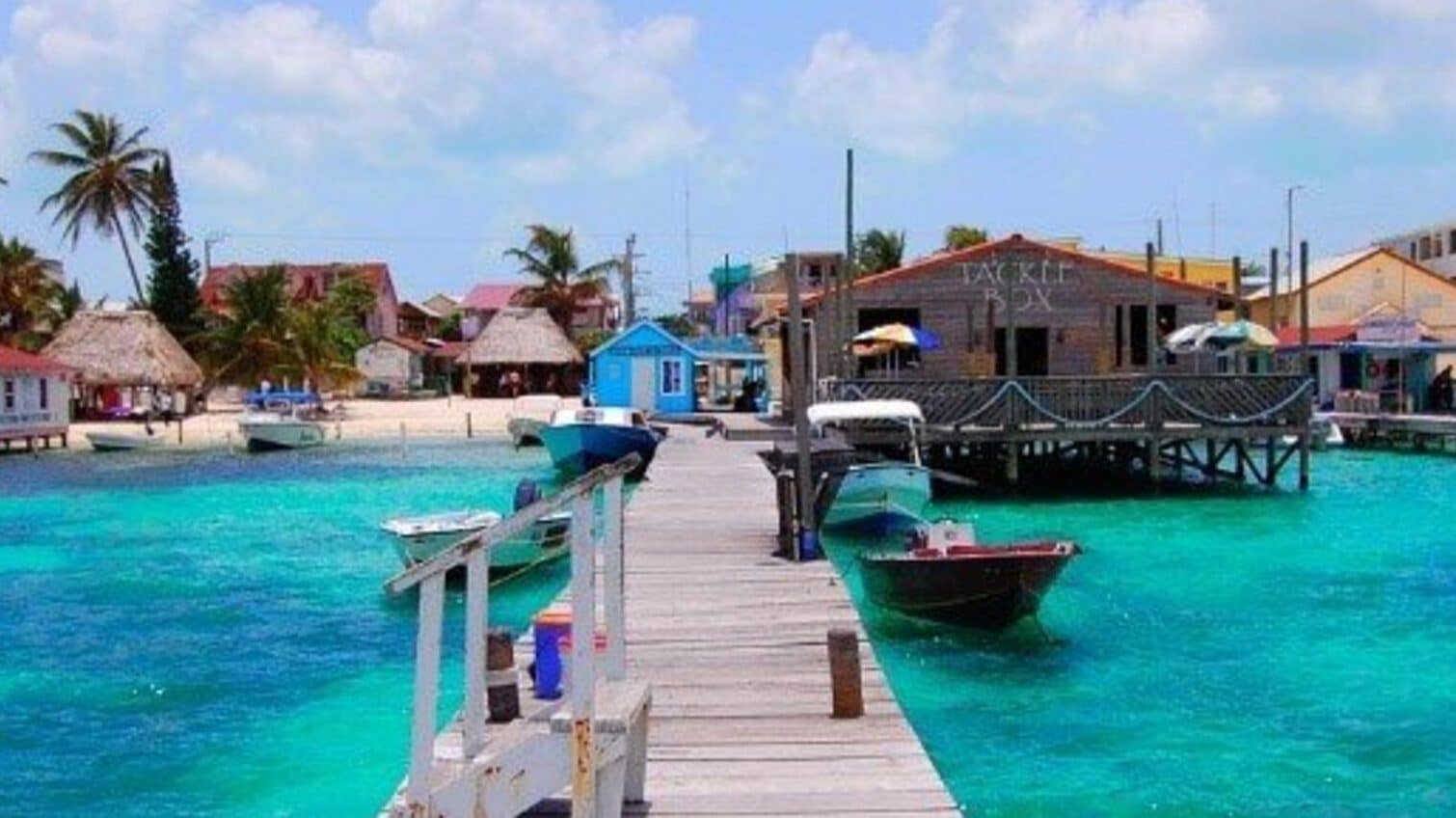Last month, we embarked on a visit to Belize as part of our Investment Climate Reform (ICR) facility intervention, aiming to evaluate the business environment for the tourism sector of Ambergris Caye. This Caribbean destination is renowned for its vibrant marine life, beaches, and the warm hospitality of its people, attracting over 60% of all visitors to Belize.
During our discussions with local stakeholders, which included entrepreneurs and community leaders, we discussed major issues for SMEs such as red tape, skills gaps, access to credit, infrastructure, among other. However, a recurring concern that emerged as a top threat to the viability of local businesses was the persistent and escalating presence of sargassum seaweed. This natural phenomenon, intensified by the impacts of climate change, poses a significant threat to the local tourism industry and its associated businesses.
The Increasing Presence of Sargassum Seaweed
Sargassum seaweed – a floating algae found initially in the Sargasso Sea – has experienced a substantial surge in growth in recent years. “The amounts of sargassum in our shores have never been this high” reported a Marianne a local hostel owner. This surge can be attributed to a multitude of factors, with climate change playing a significant role. Rising sea temperatures and altered ocean currents have created ideal conditions for the excessive proliferation of Sargassum.
These changes in the marine environment have led to unprecedented quantities of seaweed drifting towards coastal regions in the Caribbean, including the shores of Ambergris Key.
A threat for local tourism industry
Ambergris Key, known for its turquoise waters and diverse marine ecosystems, heavily relies on tourism as it main source of revenue. However, the accumulation of sargassum seaweed on the beaches affects tourists experience and has detrimental consequences for local businesses. “Some tourists end-up cutting their stay shorter” reported a local government official. The foul odor emitted by decaying seaweed, posses a real risk for tourism in destinations like Ambergris key, affecting all the tourism value chain including hotels, restaurants, water-based recreational activities, and other businesses.
A recent Study by the Inter-American Development Bank (2022) examined the impact of sargassum seaweed on coastal areas in Quintana Roo, Mexico, using nighttime lighting as a proxy of economic activity. The researchers analyzed a dataset of beach segments from 2016 to 2019 and found that the presence of sargassum led to a noticeable decrease in nighttime light intensity, indicating an approximate 11.6% reduction in local economic output. These effects were observed up to a year after the seaweed was first detected on the shoreline, resulting in economic losses ranging from 5.9% to 9.9%.

Collaborative Strategies for Mitigating the Impact of Sargassum
“Sargassum is bigger than us” said one of the local officials we met during ICR’s visit to Ambergris. Indeed, this climate change related threat cannot be solved. The local private sector will need to adapt to this reality. Mitigating the sargassum effect on the local economy requires a collaborative effort involving policy-makers, local communities and businesses. The measures to cope with this phenomenon include, among other:
- Business Continuity Planning: Businesses in the tourism sector can develop comprehensive business continuity plans that account for potential disruptions caused by sargassum influx. These plans include strategies for alternative revenue streams, diversification of offerings, and contingency plans for resource allocation and staffing during sargassum peaks. By being proactive and prepared, businesses can minimize the negative impact on their operations and maintain a level of service quality. In Cancun, Mexico, hotels have implemented business continuity plans that include alternative revenue streams. For example, some resorts have developed wellness and spa programs, eco-tourism activities, and cultural experiences to attract tourists even when beaches are affected by sargassum.
- Public-Private collaboration for early detection and treatment: Developing advanced monitoring systems and employing drones can help detect incoming sargassum mats in their early stages. Swift removal initiatives, involving local communities and businesses, can prevent the seaweed from accumulating on the beaches, preserving the island’s aesthetics and tourist appeal. In the region of Playa del Carmen (México) the local government and local businesses implemented a comprehensive sargassum management plan that involved advanced monitoring systems and swift removal initiatives.The monitoring systems utilized innovative technologies such as satellite imagery and drones to detect and track sargassum blooms in the early stages. This early detection allowed authorities to coordinate rapid response efforts and allocate resources efficiently. In Saint Lucia, the government and tourism businesses have joined forces to address the sargassum issue. They have organized community clean-up campaigns, where volunteers, including hotel staff and local residents, actively participate in removing sargassum from the beaches.
- Businesses involved in sustainable harvesting: Encouraging the development of technologies that allow for sustainable harvesting of sargassum can transform it into to a valuable resource. This harvested seaweed can be utilized for various purposes, including biofuel production, agricultural fertilizers, and bioplastics. Such initiatives can not only reduce the environmental impact of sargassum but also generate economic opportunities and promote a circular economy. The Barbados-based company, Sustainable Barbados Recycling Centre (SBRC), has implemented an innovative approach to transform sargassum into a valuable resource.
Adapting to a new reality and building back better
The impact of sargassum on the tourism industry serves as a powerful reminder of the intricate relationship between climate change and the imperative for businesses and policymakers to adapt and strive for resilience. The influx of sargassum is just one facet of the broader challenges posed by climate change to the tourism sector, with coastal destinations particularly susceptible to its effects. Rising sea temperatures, shifting weather patterns, and evolving ocean currents, among other factors, present significant risks to livelihoods and economies.
To ensure long-term sustainability and fortify resilience, it is crucial for businesses and policymakers to prioritize climate change-related impacts. Incorporating climate change considerations into private sector development policies and into business strategies becomes paramount, encompassing risk assessments, contingency planning, and substantial investments in sustainable infrastructure and practices.
Furthermore, the obstacles posed by sargassum serve as a wake-up call emphasizing the imminent climate crisis. They underscore the necessity to “build back better” by adapting to these mounting challenges and proactively preparing for future disruptions.
This publication is part of an intervention supported by the Investment Climate Reform (ICR) Facility. The ICR Facility is co-funded by the European Union (EU), the Organisation of African, Caribbean and Pacific States (OACPS) under the 11th European Development Fund (EDF), the German Federal Ministry for Economic Cooperation and Development (BMZ) and the British Council. The ICR Facility is implemented by GIZ, the British Council, Expertise France, and SNV. The contents of this publication are the sole responsibility of the author and do not necessarily reflect the views of the donors or the implementing partners.
